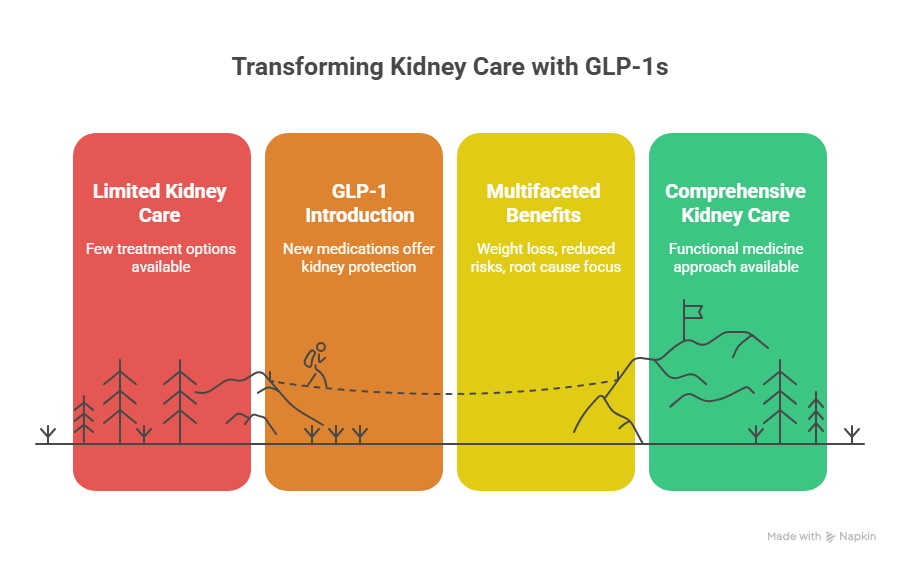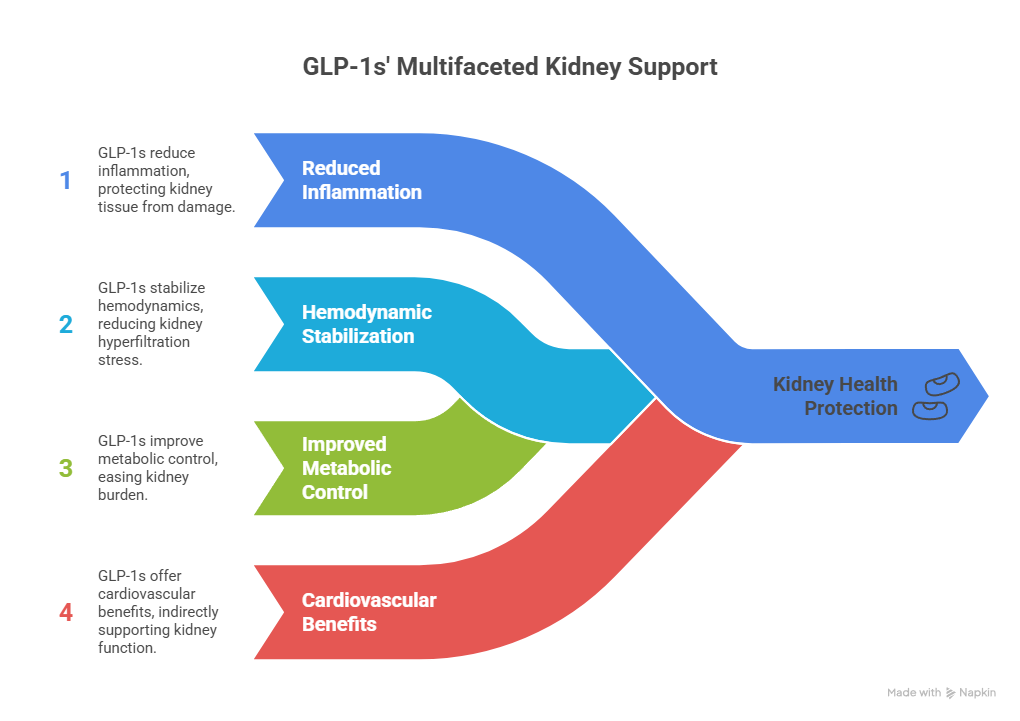
Introduction: A Paradigm Shift in Kidney Care
For decades, patients with chronic kidney disease (CKD) were told that monitoring blood pressure, managing glucose, and reducing proteinuria were the only levers they could pull. Medication options were limited, and lifestyle advice felt generic, until recently.
Today, a rising class of medications, GLP-1 receptor agonists, originally developed for diabetes, is changing the landscape of kidney care. These agents, commonly known by brand names such as Ozempic, Wegovy, and Trulicity, go far beyond blood sugar regulation. They offer powerful kidney protection, contribute to weight loss, reduce cardiovascular risks, and align beautifully with the functional medicine goal of addressing root causes over symptoms. If you’re seeking a functional medicine doctor Houston, these therapies may be an important part of your care plan.
1. GLP-1s Go Beyond Blood Sugar
When GLP-1 agonists first emerged, the primary objective was clear: improve glycemic control. But as we’ve watched their effects unfold in clinical practice, a deeper story has emerged, one in which kidney preservation is front and center.
How They Help Your Kidneys:
- Reduce proteinuria: Lowering the amount of protein in the urine indicates less kidney strain and improved filtration barrier integrity.
- Slow glomerular decline: Many patients stabilize or even slightly improve their GFR, preserving kidney function longer.
- Lower blood pressure: These medications modestly reduce blood pressure, easing pressure on the kidneys.
- Promote weight loss: Reducing obesity-related metabolic stress helps preserve both kidney and cardiovascular health.
Because chronic kidney disease is often driven by overlapping metabolic stressors, GLP-1s provide a multi-pronged advantage that tight glucose control alone cannot achieve.
2. Protective Effects Through a Functional Lens
In functional medicine, we emphasize treating the body as an interconnected system. GLP-1 agonists fit that philosophy perfectly. They support multiple pathways simultaneously, reducing inflammation, improving insulin sensitivity, supporting cardiovascular resilience, and offering direct kidney-protective effects.
Why They Align with Core Values:
- Root Cause Focus: GLP-1s address hormonal and metabolic dysfunction that drives kidney decline, not just manage symptoms.
- Systemic Benefits: They support blood sugar, body weight, blood pressure, hunger regulation, and sensitivity, all of which are interlinked with kidney health.
- Personalized Care: These medications allow personalization of dosage and timing based on metabolic and kidney function markers.
- Empowerment through Lifestyle: Many patients experience weight loss and improved energy, creating momentum for healing-centric dietary and behavioral changes.
When paired with dietary shifts, gut support, and stress management, GLP-1s can help patients step into a deeply healing model of kidney care with guidance from an experienced functional medicine doctor Houston.
3. Real-World Examples: How GLP-1 Therapy Honors Kidney Health
Patient Story:
A 52-year-old woman with stage 3 CKD, overweight, with a long history of insulin resistance and elevated A1c. She was experiencing fatigue, mild proteinuria, high blood pressure, and obesity. Traditional interventions produced minimal shifts.
When we introduced a GLP-1 agonist, the results were remarkable:
- HbA1c dropped from 8.2% to 6.1%
- Proteinuria halved, indicating reduced kidney strain
- GFR stabilized, with slight improvement
- Weight dropped by 18 pounds
- Blood pressure improved, requiring fewer medications
Side effects were minimal, and no dosage adjustment was needed for her kidney function.
The Science Behind It: Why GLP-1s Protect Kidneys
What makes GLP-1 receptor agonists uniquely capable of supporting kidney health? The mechanisms include:
- Reduced Inflammation: GLP-1s dampen pro-inflammatory pathways, limiting oxidative stress and fibrosis in kidney tissue.
- Hemodynamic Stabilization: These drugs reduce glomerular pressure and sodium retention, easing hyperfiltration stress.
- Improved Metabolic Control: Better insulin sensitivity, lower blood sugar, and weight loss reduce metabolic burden on the kidneys.
- Cardiovascular Benefits: Lower risk of heart disease and stroke indirectly stabilizes kidney function, since both systems are interdependent.

In practice, these effects are greater when combined with a holistic plan, supportive nutrition, movement, stress balance, and gut repair.
Who Should Consider GLP-1 Therapy?
You may be a good candidate if:
- You're living with type 2 diabetes or insulin resistance
- You have stage 2 or 3 CKD with early proteinuria or declining GFR
- You struggle with weight gain or metabolic syndrome
- You’ve experienced progressive kidney decline despite standard care
- You're ready to engage in lifestyle changes to amplify the drug’s benefits
What to expect:
- Personalized evaluation of kidney function, weight, blood pressure, and lifestyle
- Start low, go slow dosing strategy to minimize side effects
- Nutritional guidance emphasizing fiber, plant-based protein, and hydration
- Regular monitoring of labs: A1c, creatinine, protein in urine, blood pressure, weight
- Resilience-focused support: emotional regulation, sleep hygiene, gut therapy
GLP-1 therapy isn’t a substitute for healing strategies, it’s a catalyst. The best outcomes happen in partnership with intentional lifestyle intervention and a functional medicine doctor Houston who takes a root-cause approach.
Addressing Common Hesitations & Misconceptions
Concern: “Is it only for diabetics?”
While these medications were originally developed for diabetes, their benefits extend far beyond glucose control. Multiple studies show kidney benefits even in people with pre-diabetes or insulin resistance, without requiring advanced diabetic diagnosis.
Concern: “Are the side effects severe?”
Most patients experience mild nausea, which typically diminishes within 1–2 weeks. Starting at a low dose and gradually increasing helps improve tolerance. Serious side effects are rare when prescribed appropriately.
Concern: “Will my kidneys decline faster?”
On the contrary, when initiated carefully and monitored, GLP-1 therapy often stabilizes or modestly improves GFR. If applied without oversight, especially in very advanced CKD, dose adjustment may be needed. That’s why thoughtful, personalized care is essential.
Building a Holistic Strategy Around GLP-1 Therapy
Rather than viewing GLP-1s as a standalone solution, consider them a powerful tool integrated into a broader functional framework:
1. Nutrition that Enhances Effects
- Fiber and plant diversity support gut health and inflammation reduction.
- Balanced protein, emphasizing legumes and fish over red meat, eases metabolic burden.
- Healthy fats (olive oil, nuts, chia) support insulin and satiety pathways.
- Adopting this plate model reduces internal inflammation and supports drug effectiveness.
2. Stress and Sleep Regulation
Chronic stress blunts the effectiveness of medications by spiking insulin and inflammatory hormones. Mind/body tools are essential to complement the hormone-balancing effect of GLP-1s.
3. Movement with Intention
Physical activity improves glucose uptake and vascular function. Gentle daily movement, especially timed strategically around meals, enhances drug function without overtaxing kidneys.
4. Gut & Detox Support
Some patients experience mild GI discomfort when starting GLP-1 therapy. Supporting digestion and elimination with probiotics, natural fiber, and adequate hydration reduces discomfort and improves outcomes.
5. Regular Lab & Progress Tracking
Tracking kidneys holistically, not just creatinine, is key. Monitor:
- A1c and insulin markers
- eGFR and proteinuria
- Blood pressure trends
- Weight and waist circumference
This approach allows for real-time adjustments tailored to your body’s response.
Values That Are at the Heart of This Approach
Empowerment – Patients regain confidence in their capacity to restore health rather than surrender to decline.
Collaboration – You are the expert in your body. My role is to guide, educate, and support, not dictate.
Science-Driven, Individualized – We rely on robust evidence around GLP-1 effects, and tailor them to your unique physiology.
Whole-System Perspective – Kidneys don’t fail in isolation. When we support metabolic, emotional, gut, and cardiovascular systems, kidneys benefit too.
Safety First – By integrating a medication into a broader functional strategy, side effects are minimized, and outcomes are maximized.
Final Thoughts: A New Chapter in Kidney Care
GLP-1 receptor agonists are more than just diabetes drugs, they are a paradigm shift for kidney disease management. They embody the possibility that medication can align with holistic healing, helping people regain metabolic balance, reduce inflammation, and protect their kidneys in the process.
If you're facing kidney decline, pre-diabetes, insulin resistance, or unexplained weight gain, GLP-1 therapy might be the missing piece in your care plan. But the most effective results come when medication is combined with lifestyle shifts and emotional support.
Your kidneys deserve more than symptom suppression, they deserve restoration. GLP-1s offer a powerful tool on that journey, one that respects your body’s wisdom and empowers you to participate in the healing process.
Special Offer: Take $50 off your first visit and explore how GLP-1 therapy, combined with personalized root-cause medicine, can transform your kidney health.Ready to embark on a healing journey that integrates proven medication with holistic care? schedule with Dr. Bismah at drbismah.com.
